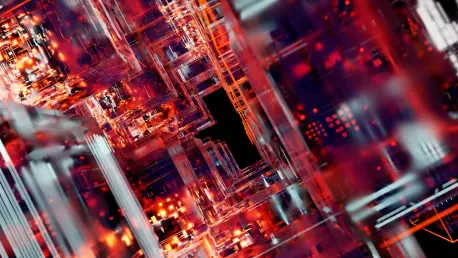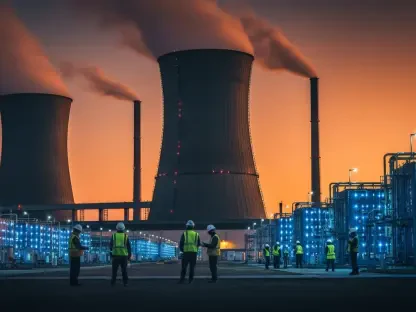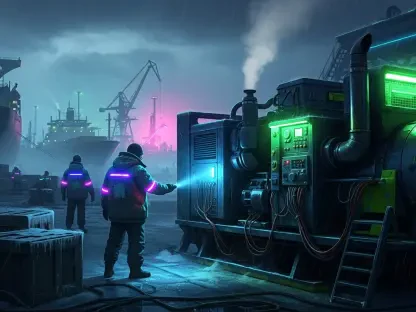In a world where artificial intelligence shapes everything from daily tasks to global economies, the invisible backbone supporting this revolution often goes unnoticed, yet it plays a critical role in sustaining technological progress. Data centers, the powerhouses behind AI’s rapid ascent, are grappling with an unprecedented demand for capacity and energy in 2025. With power grids straining under the weight of Big Tech’s needs, one company stands at the forefront of this critical junction: Schneider Electric. How is this French industrial giant addressing the colossal challenges of the AI era, and what does its involvement mean for the future of technology? This exploration dives into the heart of an industry under pressure, revealing the innovative strides being made to keep the digital world humming.
Why Data Centers Fuel the AI Revolution
At the core of every AI breakthrough lies a sprawling network of servers humming in data centers across the globe. These facilities are not just warehouses of tech; they are the lifeblood of machine learning models that process vast datasets in real time. The explosion of AI applications, from generative tools to autonomous systems, has driven an insatiable need for more computing power, pushing data center capacity to its limits. Without these hubs, the promise of AI would remain a distant dream, stalled by a lack of infrastructure to support its growth.
The urgency of this situation becomes clear when considering the sheer scale of demand. Industry reports indicate that the global appetite for data center resources has surged by over 40% in recent years, largely due to AI workloads. This trend shows no signs of slowing, as businesses and governments alike lean on AI to solve complex problems. The challenge, therefore, is not just about building more facilities but ensuring they can operate efficiently under extreme computational stress.
Schneider Electric emerges as a key player in this landscape, offering solutions that bridge the gap between ambition and reality. By focusing on scalable infrastructure, the company addresses the foundational needs of AI-driven enterprises. This pivotal role sets the stage for understanding how such innovations are not merely technical fixes but essential components of a broader technological shift.
The Energy Crisis Shadowing AI’s Rise
While AI promises transformative change, it comes with a hidden cost: an enormous energy footprint that threatens to overwhelm existing power systems. Data centers supporting AI operations consume electricity at a staggering rate, with some estimates suggesting they account for nearly 2% of total U.S. energy usage in 2025. This voracious appetite has put immense pressure on utilities, raising concerns about grid stability and the environmental impact of unchecked consumption.
Beyond the numbers, the issue resonates with broader societal implications. As Big Tech companies expand their AI capabilities, the risk of blackouts or energy shortages grows, potentially affecting communities far removed from Silicon Valley. Morgan Stanley analysts project that global data center power demand could nearly triple by 2027, intensifying the urgency for sustainable solutions. This looming crisis underscores why energy management is as critical as computing power in the AI narrative.
Schneider Electric’s expertise in this domain offers a lifeline amid these challenges. By prioritizing energy-efficient technologies, the company aims to curb the proportional rise in power needs as AI capacity scales. This focus not only addresses immediate operational hurdles but also aligns with growing calls for sustainability in tech, positioning Schneider as a leader in navigating the energy dilemma.
Schneider Electric’s Landmark Deals in AI Infrastructure
Stepping into the spotlight, Schneider Electric has secured game-changing contracts that highlight its influence in the AI data center arena. Two major agreements, totaling nearly $2.3 billion, were struck with U.S. operators Switch and Digital Realty. The larger deal, a $1.9 billion partnership with Switch, centers on delivering power modules and cutting-edge cooling systems, marking one of the most significant contracts of its kind in North America.
The second contract, valued at $373 million with Digital Realty, focuses on providing uninterruptible power supplies and switchgear, crucial for maintaining seamless operations under AI’s heavy workloads. These deals, structured for phased delivery through 2025 and 2026, ensure a steady supply of infrastructure tailored to the unique demands of AI processing. Additionally, a collaboration with Nvidia to develop cooling solutions for high-performance AI chips showcases Schneider’s commitment to tackling heat dissipation, a notorious issue in dense computing environments.
These initiatives are more than just business transactions; they represent a strategic response to the industry’s most pressing needs. By equipping data centers with specialized tools to handle intensive tasks, Schneider Electric is directly addressing the bottlenecks that could hinder AI’s expansion. Each contract reflects a deep understanding of the balance required between performance and resource management, cementing the company’s reputation as an innovator in this space.
Expert Perspectives on Schneider’s Market Leadership
Industry voices offer a clear endorsement of Schneider Electric’s strategic moves in the data center sector. Vandana Singh, Senior Vice President at Schneider’s North American secure power division, has emphasized the inadequacy of traditional infrastructure for AI’s demands, stating, “Current systems simply can’t keep pace with the computational intensity of modern AI workloads.” Her insights point to the necessity of advanced cooling and power technologies, areas where Schneider excels.
Analysts are equally optimistic about the company’s trajectory, especially as hyperscalers like Amazon, Google, and Microsoft are expected to invest over $360 billion in AI infrastructure this year alone. Financial experts are keenly observing Schneider’s upcoming capital markets day in London, anticipating detailed updates on its AI-focused strategies. This event is seen as a platform to outline how the company plans to sustain its edge in a competitive market driven by relentless innovation.
Such perspectives paint a broader picture of consensus within the tech ecosystem. The alignment between Schneider’s offerings and the industry’s needs suggests a forward-thinking approach that resonates with both operators and investors. This collective confidence underscores the pivotal role of customized solutions in supporting AI’s growth, highlighting why Schneider remains a trusted name amid rapid evolution.
Innovative Strategies for a Sustainable AI Future
Addressing the dual challenge of AI expansion and energy constraints requires practical, scalable solutions, and Schneider Electric delivers on this front with precision. The company’s advanced cooling systems are designed to manage the intense heat generated by AI servers, reducing energy waste while maintaining peak performance. These technologies are complemented by power management tools that optimize electricity usage, ensuring data centers operate without overloading grids.
Another cornerstone of Schneider’s approach is its phased delivery model, which allows for incremental infrastructure upgrades over the coming years. This strategy prevents bottlenecks during deployment and enables operators to adapt to evolving demands. Equipment like server racks and uninterruptible power supplies further supports this adaptability, providing robust frameworks for handling AI’s rigorous requirements without compromising reliability.
Perhaps most notably, these solutions directly tackle the strain on U.S. power systems by embedding efficiency into every layer of design. By minimizing energy spikes and enhancing operational stability, Schneider Electric offers a blueprint for balancing technological ambition with environmental responsibility. This holistic focus ensures that the AI boom can continue without triggering unsustainable consequences, providing a model for others in the industry to follow.
Reflecting on a Transformative Journey
Looking back, Schneider Electric’s $2.3 billion partnerships with Switch and Digital Realty stood as defining moments in the AI data center landscape. These agreements, executed with a keen eye on both innovation and sustainability, showcased how targeted infrastructure could support the relentless pace of technological advancement. The collaboration with Nvidia on cooling systems further highlighted a commitment to addressing niche challenges that shaped the industry’s trajectory.
As the narrative unfolded, the integration of energy-efficient technologies proved to be a linchpin in mitigating the power crises that loomed over Big Tech. The strategic foresight embedded in phased deliveries and scalable equipment offered a buffer against the unpredictability of AI’s growth. These efforts collectively painted a picture of resilience, demonstrating that progress and responsibility could coexist even under intense pressure.
Moving forward, the focus shifts to actionable next steps, with industry stakeholders urged to prioritize investments in sustainable data center solutions. Policymakers and tech leaders alike face the task of aligning energy policies with the realities of AI’s demands, ensuring grids can withstand future surges. Schneider Electric’s journey serves as a reminder that innovation, when paired with strategic planning, holds the key to unlocking AI’s full potential without sacrificing the planet’s well-being.









